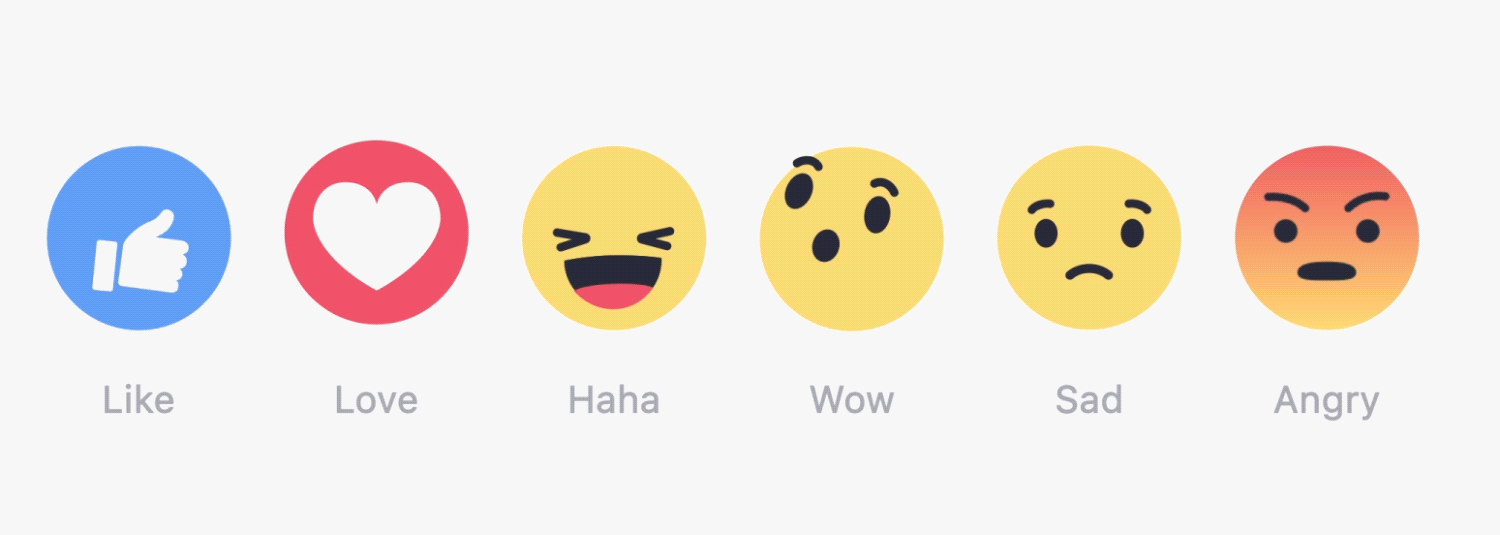Now brands on Facebook will not only be liked with the iconic thumbs-up by their fans. The social media network has added five more emotions for users to show how they feel about brands and posts. Facebook Reactions were launched globally last week, but what does it mean for social video marketing?
Facebook Reactions’ animated emojis
Now on Facebook, we can be slightly more nuanced in our feelings for brands. These reactions take the form of animated emojis – love, haha, wow, sad, angry. The new range of emojis are partly a reaction to increased mobile usage where people want easier ways to react rather than commenting. Mobile daily active users were are an average of 934 million per day in December 2015 – up 25% YoY.

On the Facebook blog, Sammi Krug, product manager said:
“For more than a year we have been conducting global research including focus groups and surveys to determine what types of reactions people would want to use most. We also looked at how people are already commenting on posts and the top stickers and emoticons as signals for the types of reactions people are already using to determine which reactions to offer.”
What do Facebook Reactions mean for marketing?
- Customer insight
These new emojis will give brands greater insight into how their fans feel about their video content. Are they laughing or saying “Wow”? It gives a more nuanced insight into the interaction with the content.
An article in Wired argues that advertisers love the new emojis, and potentially it could help to add to Facebook’s already focussed targeting. Brands could target ads based on previous reactions to their content. At the moment, all emojis will be treated the same as an engagement, but Facebook haven’t ruled out weighting these reactions in their analytics.
- Fewer comments
In their research for the new emojis, Facebook found that people commented more when the content of the post was about something sad, rather than just pressing ‘like’. Now that people have more emotions to share, brands may find that there are fewer comments posted as people use the emojis to express themselves. This may pose challenges for community managers in that comments are a useful for way to engage with fans and build relationships.
- Watch negativity
Facebook fans have been crying out for a dislike button for some time, but that has been ruled out as it could impact badly on the user experience. The angry or sad button could be used by fans to complain, but it could be difficult for the community manager to identify the exact problem or issues.
- Emotional brand content
The addition of these options to express feelings once again reinforces the importance of making an emotional connection via audiences via social video especially with increased mobile usage. To engage, brands must make an early emotional connection with their users in video content. Brands need to be combining data with brand personas and the context of viewing to find out what makes customers emote.
Social video content – brand reactions
Automotive brand, Chevrolet were quick to get in with a social video in their “like to love” campaign.
With Mobile World Congress in full swing, tech telecoms brand, Samsung created VR emojis.
Beleef emoties intenser met de #GearVR. #FacebookReactions pic.twitter.com/uPVpDRIlnb
— Samsung België (@SamsungBelgie) 25 February 2016
XBox gave the new Reactions’ emojis a real-time marketing brand twist.
We decided to make Facebook Reactions a little more gamer friendly… https://t.co/M7toHkvYpA pic.twitter.com/lK6Sl67xDb
— Xbox UK (@xboxuk) 25 February 2016
Facebook will be tracking its users’ interactions with these new emojis. Product design director at the social media corporation, Geoff Teehan said:
“We’ll be continuing to learn, iterate and improve upon it, but we’re hopeful this is a step towards a more empathetic Facebook experience.”
What do you think of the new icon? Were Facebook wise to diminish their brand icon – the like button? Will brands be disappointed with a like rather than a love? Let us know via Twitter.